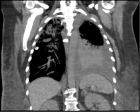Abstract
Case Report
Avoiding confusion in high flow oxygen therapy concepts
García G, Valencia P, Mercedes E, Sarhane Y, Díaz-Lobato S* and Agosta M
Published: 31 May, 2017 | Volume 1 - Issue 1 | Pages: 001-002
Oxygen therapy is the main supportive treatment in hypoxemic respiratory failure and has traditionally been delivered using low and high flow devices. However, the maximal flow rates that these devices can deliver are limited because of the insufficient heat and humidity provided to the gas administered. Low flow devices such as the nasal cannula, conventional face mask and reservoir bag deliver a flow rate of up to 15 L/min by administering more variable oxygen fractions (FiO2), depending on the patient’s respiratory pattern, peak inspiratory flow and characteristics of the devices. Conventional high flow devices, such as venturi type masks, utilize a constant flow of oxygen through precisely sized ports, entraining the ambient air, using the Bernoulli principle, providing a more constant inspired oxygen fraction. However, they are less tolerated than nasal cannulas because they are less comfortable and the insufficient humidification and heating of the gas delivered [1].
In the last two decades, new devices have been developed to administer high humidified and heated flow through a nasal cannula (HFNC) that also allows the delivery of oxygen with a known FiO2 up to 100%. In the literature, this technique has also been called mini CPAP (continuous positive airway pressure), transnasal insufflation, high nasal flow ventilation, high flow oxygen therapy, and high flow nasal cannula oxygen therapy [2].
It is considered that high flow nasal cannula has certain benefits compared to those of oxygen therapy previously detailed. HFNC manages a flow of more than 30 L/min, which is able to surpass the peak inspiratory flow of the patient, being able to reach values between 60-80 L/min depending on the flow used. The gas source, which may be delivered by an air/oxygen blender, fans, or a flow generating turbine, is connected by an active humidifier to a nasal cannula and the FiO2 can be adjusted independently of the flow.
From a clinical point of view, there is some confusion between venturi and high flow nasal cannula devices. In the literature, both have been considered as high flow oxygen therapy devices. In our opinion this is not appropriate because the high nasal cannula flow is much more than a simple system for administering oxygen therapy [3]. Venturi-type masks provide the patient with a gas mixture with a controlled FiO2, but do not exert additional benefits on the ventilator mechanics of the patient. Nevertheless, HFNC allows the delivery of a high flow, which can also add oxygen therapy, providing a series of physiological effects that imply an active treatment to respiratory failure.
Effects related to HFNC include the following:
1. Delivery of higher and more stable FiO2 values, because the flow delivered is greater than the patient’s inspiratory demand.
2. The anatomical dead space decreases by washing the nasopharynx, consequently increases alveolar ventilation. This improves the thoracoabdominal synchrony.
3. Respiratory work decreases because it acts as a mechanical stent in the airway and markedly attenuates inspiratory resistance.
4. The gas administered is warmed and humidified, improving mucociliar clearance, reducing the risk of atelectasis, improving ventilation perfusion and oxygenation ratio.
5. There is a CPAP-like effect. The dynamic positive espiratory airway pressure generated by HFNC reaches a value between 6-8cmH2o depending on the flow and the size of the cannula. This positive pressure distends the lungs and ensures their recruitment.
6. Pulmonary end-expiratory volume is higher with HFCN than with conventional high-flow oxygen therapy.
7. In addition, the technique is considered easy and simple for the medical staff and nurses, and can be used in different areas (emergency, hospitalization, critical care unit, weaning centers) and even at home [4].
Currently available evidence has demonstrated that HFNC therapy is an alternative for the treatment of acute hypoxemic respiratory failure, hypercapnic respiratory failure, acute heart failure, as rescue therapy preventive therapy in post-extubation respiratory failure and in specific conditions such as bronchoscopy [5].
We believe that high-flow nasal cannula treatment should not be confused with high flow oxygen therapy of venturi masks. According to detailed mechanisms of action, HFNC is not limited to being only an oxygen therapy system but also behaves as a true treatment that can be used in different clinical scenarios, generating physiological benefits that result in the reduction of respiratory work. In addition, in venturi type masks, the air is not humidified and complications such as dryness and nasal pain are common, generating a poor tolerance to oxygen therapy. The benefits of proper humidification and heating of the gas delivered with HFNC therapy allow better comfort and tolerance of the patient with easy adherence to the treatment. All this contributes to making HFNC be considered a technique of choice in patients with hypoxemic respiratory failure. The growth in its use associated with easy acceptance for patients and the expansion in its application show us that HFNC is a promising therapy.
Read Full Article HTML DOI: 10.29328/journal.jprr.1001001 Cite this Article Read Full Article PDF
References
- Spoletini G, Alotaibi M, Blasi F, Hill NS. Heated Humidified High Flow Nasal Oxygen in Adults, mechanism of action and clinical implications. Chest. 2015; 148: 253-261. Ref.: https://goo.gl/1NZOVm
- Nishimura M. High Flow Nasal Cannula Oxygen Therapy in Adults. J Intensive Care. 2015; 3: 15. Ref.: https://goo.gl/YiBA4k
- Díaz-Lobato S, Alonso JM, Carratalá JM, Mayoralas S. High Flow Nasal Oxygen is not an oxygen therapy device. Rev Prot Pneumol. 2015; 23: 51-52. Ref.: https://goo.gl/yTn1c7
- Díaz-Lobato S, Mayoralas S. New approaches to the treatment of respiratory failure: High flow therapy. Med Clin (Barc). 2016; 147: 397-398. Ref.: https://goo.gl/irDqAD
- Roca O, Hernández G, Díaz-Lobato S, Carratalá JM, Gutierrez R, et al. Current evidence for the effectiveness of heated and humidified high flow nasal cannula supportive therapy in adult patient with respiratory failure. Crit Care. 2016; 20: 109. Ref.: https://goo.gl/xAMA5H
Similar Articles
-
Avoiding confusion in high flow oxygen therapy conceptsGarcía G,Valencia P,Mercedes E, Sarhane Y,Díaz-Lobato S*,Agosta M. Avoiding confusion in high flow oxygen therapy concepts. . 2017 doi: 10.29328/journal.jprr.1001001; 1: 001-002
-
Acute and chronic changes in massive Barium Sulfate aspiration in an infant who subsequently was diagnosed with severe Gastro-esophageal RefluxSevgi Pekcan*. Acute and chronic changes in massive Barium Sulfate aspiration in an infant who subsequently was diagnosed with severe Gastro-esophageal Reflux . . 2017 doi: 10.29328/journal.jprr.1001002; 1: 003-008
-
Successful Therapy with intravenous gamma globulin in two children with postinfectious bronchiolitis obliteransSevgi Pekcan,Bahar Gökturk*, Ismail Reisli. Successful Therapy with intravenous gamma globulin in two children with postinfectious bronchiolitis obliterans. . 2017 doi: 10.29328/journal.jprr.1001003; 1: 009-012
-
Fluticasone furoate/Vilanterol 92/22 μg once-a-day vs Beclomethasone dipropionate/Formoterol 100/6 μg b.i.d. in asthma patients: a 12-week pilot studyClaudio Terzano*,Francesca Oriolo. Fluticasone furoate/Vilanterol 92/22 μg once-a-day vs Beclomethasone dipropionate/Formoterol 100/6 μg b.i.d. in asthma patients: a 12-week pilot study . . 2017 doi: 10.29328/journal.jprr.1001004; 1: 013-022
-
A decade of targeted therapy for non-small cell lung cancerKhalid Abu Ajaj*. A decade of targeted therapy for non-small cell lung cancer. . 2017 doi: 10.29328/journal.jprr.1001005; 1: 023-027
-
Successful treatment of late-onset pulmonary hypertension after atrial septal defect operation with macitentan: Our center experienceTarik Kivrak*,Zeynep Ulutas,Sena Sert, Bulent Mutlu. Successful treatment of late-onset pulmonary hypertension after atrial septal defect operation with macitentan: Our center experience . . 2018 doi: 10.29328/journal.jprr.1001006; 2: 001-003
-
Effect of diabetes mellitus on the Pulmonary Function Tests in Sudanese Diabetic PatientsElmutaz H Taha,Ibrahim A Ali*,Omer A Musa. Effect of diabetes mellitus on the Pulmonary Function Tests in Sudanese Diabetic Patients . . 2018 doi: 10.29328/journal.jprr.1001007; 2: 004-010
-
COPD and low plasma vitamin D levels: Correlation or causality?Luca Gallelli*, Erika Cione,Stefania Zampogna, Gino Scalone. COPD and low plasma vitamin D levels: Correlation or causality? . . 2018 doi: 10.29328/journal.jprr.1001008; 2: 011-012
-
Peculiarities of photon emisson of whole non-diluted human blood obtained from healthy donors and patients with some diseasesKirill N Novikov*,Vladimir L Voeikov,Ekaterina V Buravleva,Nadezhda G Berdnikova. Peculiarities of photon emisson of whole non-diluted human blood obtained from healthy donors and patients with some diseases . . 2018 doi: 10.29328/journal.jprr.1001009; 2: 013-019
-
Stethoscope - Over 200 yearsHenrik Permin*,Svend Norn . Stethoscope - Over 200 years . . 2019 doi: 10.29328/journal.jprr.1001010; 3: 001-008
Recently Viewed
-
Atypical Anti-GBM with ANCA Vasculitis- A Rarest of the Rare Entity: Index Case from Eastern IndiaGopambuj Singh Rathod*, Atanu Pal, Pallavi Mahato, Aakash Roy, Debroop Sengupta, Muzzamil Ahmad. Atypical Anti-GBM with ANCA Vasculitis- A Rarest of the Rare Entity: Index Case from Eastern India. J Clini Nephrol. 2024: doi: 10.29328/journal.jcn.1001139; 8: 124-126
-
Gallstone Ileus: A Rare Case of Intestinal Obstruction, Presented in a Chronic Kidney Disease Patient on HaemodialysisPulak Azad*,Yasir Sultan Rizvi,Lakshmi Kant Jha,Pranav Tyagi,Sachin Jain,Twinkle Malik. Gallstone Ileus: A Rare Case of Intestinal Obstruction, Presented in a Chronic Kidney Disease Patient on Haemodialysis. J Clini Nephrol. 2025: doi: 10.29328/journal.jcn.1001149; 9: 027-030
-
A Case of Rapidly Progressive Renal Failure with Unearthed AmyloidosisPulak Azad*,Lakshmi Kant Jha,Yasir Sultan Rizvi,Pranav Tyagi. A Case of Rapidly Progressive Renal Failure with Unearthed Amyloidosis. J Clini Nephrol. 2025: doi: 10.29328/journal.jcn.1001140; 9: 024-026
-
An Adult Case of Beta Thalassemia with Right Ventricular Outflow Tract Tachycardia: A Case ReportPrem AS,Shahanas PS,Praveen Sreekumar*,Ramaswamy NV. An Adult Case of Beta Thalassemia with Right Ventricular Outflow Tract Tachycardia: A Case Report. J Cardiol Cardiovasc Med. 2024: doi: 10.29328/journal.jccm.1001201; 9: 177-179
-
Autoantibodies in Autoimmune Addison’s Disease: Why are they Important?Maria Rosaria De Cagna, Norma Notaristefano, Maurizio Schiavone, Gianluca Palatella, Federica Ranù, Carmela Presicci, Valerio Cecinati, Marilina Tampoia*. Autoantibodies in Autoimmune Addison’s Disease: Why are they Important?. Arch Pathol Clin Res. 2024: doi: 10.29328/journal.apcr.1001042; 8: 012-015
Most Viewed
-
Evaluation of Biostimulants Based on Recovered Protein Hydrolysates from Animal By-products as Plant Growth EnhancersH Pérez-Aguilar*, M Lacruz-Asaro, F Arán-Ais. Evaluation of Biostimulants Based on Recovered Protein Hydrolysates from Animal By-products as Plant Growth Enhancers. J Plant Sci Phytopathol. 2023 doi: 10.29328/journal.jpsp.1001104; 7: 042-047
-
Sinonasal Myxoma Extending into the Orbit in a 4-Year Old: A Case PresentationJulian A Purrinos*, Ramzi Younis. Sinonasal Myxoma Extending into the Orbit in a 4-Year Old: A Case Presentation. Arch Case Rep. 2024 doi: 10.29328/journal.acr.1001099; 8: 075-077
-
Feasibility study of magnetic sensing for detecting single-neuron action potentialsDenis Tonini,Kai Wu,Renata Saha,Jian-Ping Wang*. Feasibility study of magnetic sensing for detecting single-neuron action potentials. Ann Biomed Sci Eng. 2022 doi: 10.29328/journal.abse.1001018; 6: 019-029
-
Pediatric Dysgerminoma: Unveiling a Rare Ovarian TumorFaten Limaiem*, Khalil Saffar, Ahmed Halouani. Pediatric Dysgerminoma: Unveiling a Rare Ovarian Tumor. Arch Case Rep. 2024 doi: 10.29328/journal.acr.1001087; 8: 010-013
-
Physical activity can change the physiological and psychological circumstances during COVID-19 pandemic: A narrative reviewKhashayar Maroufi*. Physical activity can change the physiological and psychological circumstances during COVID-19 pandemic: A narrative review. J Sports Med Ther. 2021 doi: 10.29328/journal.jsmt.1001051; 6: 001-007

HSPI: We're glad you're here. Please click "create a new Query" if you are a new visitor to our website and need further information from us.
If you are already a member of our network and need to keep track of any developments regarding a question you have already submitted, click "take me to my Query."






















































































































































